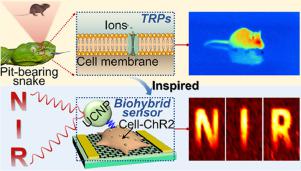Acta Biomaterialia ( IF 9.4 ) Pub Date : 2023-01-11 , DOI: 10.1016/j.actbio.2023.01.017 Jia Yang 1 , Lipeng Zu 1 , Gongxin Li 2 , Chuang Zhang 3 , Zhixing Ge 1 , Wenxue Wang 3 , Xiaoduo Wang 3 , Bin Liu 3 , Ning Xi 4 , Lianqing Liu 3

|
Living organisms are far superior to state-of-the-art devices in visual perception as they have evolved a wide number of capabilities that encompass our most advanced technologies. By leveraging the performance of living organisms and directly interfacing them with artificial components, it can use the intricacy and metabolic efficiency of biological visual sensing within artificial machines. Inspired by the molecular basis (transient receptor potential, TRP) for infrared detection of pit-bearing organisms, we propose a TRP-like biohybrid sensor by integrating upconversion nanoparticles (UCNP) and optogenetically engineered cells on a graphene transistor for infrared sensing and imaging. The UCNP converts infrared light irradiation into blue light, the blue light activates the cells expressed with channelrhodopsin-2 (ChR2) and induces transmembrane photocurrent, and the photocurrent is detected by a biocompatible graphene transistor. Stepwise and overall experimental results show that, upon infrared light irradiation, the UCNP can rapidly mediate cellular photocurrents, which further translates into the extra output current of the graphene transistor. More notably, the response speed of the biohybrid sensor is 1∼3 orders of magnitude faster than those of TRPs heterologously expressed in cell lines in the literature, which confirms the response time advantage of the combination of UCNP and ChR2 within the sensor in place of TRPs. The biohybrid sensor can successfully image infrared targets, proving the feasibility of developing bionic infrared sensing devices by biohybrid integration of nonliving nanomaterials and biological components. This work opens up an avenue for biohybrid sensors to develop the bionic infrared vision that promisingly reproduces the functional superiority of natural organisms.
Statement of significance
Infrared sensing and imaging have a wide range of military and civilian applications. Organisms have evolved excellent infrared vision with the molecular basis, transient receptor potential (TRP), and the performance is superior to existing state-of-the-art infrared devices. Inspired by this, a TRP-like biohybrid sensor based on upconversion optogenetics and a 2D material-based device is developed for infrared sensing and imaging. The biohybrid sensor has a relatively fast response speed that is 1∼3 orders of magnitude faster than that of the heterologously expressed TRPs, which enables its capability of infrared imaging with a single pixel-based method. This work broadens the spectrum of biohybrid sensing based on engineered cells to infrared, advancing the process of reproducing the excellent infrared detection of organisms.
中文翻译:

用于红外传感和成像的上转换光遗传学驱动的生物混合传感器
生物体在视觉感知方面远远优于最先进的设备,因为它们已经进化出大量包含我们最先进技术的能力。通过利用生物体的性能并将它们与人工组件直接连接,它可以利用人工机器内生物视觉传感的复杂性和代谢效率。受用于红外探测带坑生物的分子基础(瞬时受体电位,TRP)的启发,我们通过将上转换纳米粒子(UCNP)和光遗传工程细胞集成在石墨烯晶体管上用于红外传感和成像,提出了一种类似 TRP 的生物混合传感器。UCNP将红外光照射转化为蓝光,蓝光激活表达通道视紫红质 2 (ChR2) 的细胞并诱导跨膜光电流,该光电流由生物相容性石墨烯晶体管检测。逐步和全面的实验结果表明,在红外光照射下,UCNP 可以快速调节细胞光电流,进一步转化为石墨烯晶体管的额外输出电流。更值得注意的是,生物混合传感器的响应速度比文献中在细胞系中异源表达的 TRP 快 1∼3 个数量级,这证实了传感器内 UCNP 和 ChR2 组合的响应时间优势代替了TRP。生物混合传感器可以成功成像红外目标,证明通过非生命纳米材料和生物成分的生物混合集成开发仿生红外传感装置的可行性。这项工作为生物混合传感器开辟了一条途径,以开发仿生红外视觉,有望再现自然生物的功能优势。
重要性声明
红外传感和成像具有广泛的军事和民用应用。生物体以分子基础瞬时受体电位(TRP)进化出出色的红外视觉,性能优于现有的最先进的红外设备。受此启发,开发了一种基于上转换光遗传学和基于二维材料的器件的类 TRP 生物混合传感器,用于红外传感和成像。生物混合传感器具有相对较快的响应速度,比异源表达的 TRP 快 1∼3 个数量级,这使其能够使用基于单像素的方法进行红外成像。这项工作将基于工程化细胞的生物混合传感的光谱扩展到红外,推进了再现生物体卓越红外检测的过程。





















































 京公网安备 11010802027423号
京公网安备 11010802027423号